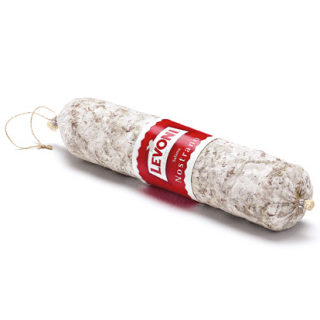Provolone Valpadana POD
Provolone Valpadana PDO comes from the family of pasta filata (spun paste) cheeses, which are characterised by the technique of "spinning" the curd, which has ancient origins.
The first notes of this cheese date back to the Middle Ages and come from Southern Italy, the birthplace of the particular production technique. Since 1996, Provolone Valpadana has prided itself on its "PDO", Protected Designation of Origin.
Provolone Valpadana PDO is a "pasta filata" (spun paste) cheese with the greatest variety of shapes and weights of any other dairy product. The plasticity of the paste, characteristic to Provolone Valpadana PDO, during processing, allows cheese makers to dabble in producing forms of an albeit infinite variety of weights. Even today, you can see at the ripening warehouses of dairy producers, some "experiment" being carried out by a creative cheese maker. The product specification for Provolone Valpadana PDO (DPCM 04/09/1993) has safeguarded this cheese culture through the identification of a geometric type, replicated in the different weights.
We can distinguish four typical forms: salami, melon/pear, truncated cone and flask, each of which can be produced in weights ranging from 500g to over 100kg.
We must mention the two types of Provolone Valpadana PDO:
- "Dolce", which is distinguished by the use of veal rennet and is aged for no more than 2-3 months;
- "Piccante", which is distinguished by the use of kid and/or lamb rennet paste and is aged for a minimum of 3 months to over a year.
The flavour, aroma and look of Provolone Valpadana PDO are best enjoyed fresh and uncooked.
It is delicious when paired with bread: the best type of bread to serve with Provolone Valpadana piccante (sharp) would be made from Altamura durum wheat, whereas the dolce (sweet) version is best served with sesame bread or classic pain rosette rolls.
Typical preserves from Cremona also provide the perfect accompaniment this ancient peasant cheese, as does honey and some jams – fig jam in particular.
Wine pairing
The best wine pairings depend on the type of Provolone Valpadana PDO:
Provolone Valpadana PDO dolce (sweet):
• Classically made spumante wines: from Franciacorta to Trento classico, Classese dell’Oltrepò Pavese, Alta Langa Piemontese and Erbaluce di Caluso spumante from Piedmont;
• Medium white wines such as Roero Arneis (Piedmont), Nosiola (Trentino), Tocai (Friulano), Frascati (Lazio), Vermentino (from either Sardinia or Liguria), Ortrugo (Colli Piacentini), Petit Arvine (Valle d’Aosta), Durello (Monti Lessini) or Grechetto (Umbria);
• Young medium red wines such as Dolcetto (Piedmont), Groppello (Garda), Teroldego Rotaliano (Trentino), Lagrein (Alto Adige), Lambrusco secco (Emilia Romagna), Rosso Piceno (Marche), Chianti Rufina or Colli Fiorentini (Tuscany), Castel del Monte, including rosé (Puglia), Etna rosso (Sicily), Ruchè di Castagnole Monferrato (Piedmont), Gutturnio frizzante (Emilia Romagna), Lacrima di Morro d’Alba (Marche) or Cesanese (Lazio).
Provolone Valpadana PDO piccante (sharp):
• Classically made spumante wines from the areas mentioned above.
• Well-structured white wines, including those aged in wooden barrels, such as Gavi (Piedmont), Terre di Franciacorta bianco (Lombardy), Soave (Veneto), Verdicchio dei Castelli di Jesi (Marche), Vernaccia di San Gimignano (Tuscany), Fiano (Campania), Timorasso dei colli Tortonesi (Piedmont), Malvasia dei Colli Piacentini (Emilia Romagna) and Lugana superiore (Veneto);
• Well-structured red wines, such as Barbera d’Asti (Piedmont), Valtellina Sforzato (Lombardy), Pignolo (Friuli), Rosso Conero (Marche), Nobile di Montepulciano (Tuscany), Aglianico (Campania), Primitivo di Manduria or Negroamaro (Puglia), Cannonau (Sardinia), Gattinara (Piedmont) and Buttafuoco (Lombardy).
When serving Provolone Valpadana PDO piccante with honey or other sweet preserves, it's also possible to pair it with sweet wines made from dried grapes or late-harvested varieties, such as Piemonte Moscato passito, Moscato di Chambave (Valle d’Aosta), Albana (Romagna), as well as late-harvested Verdicchio dei Castelli di Jesi (Marche), Passito di Pantelleria, Malvasia delle Lipari (Sicily), Picolit (Friuli), Cinqueterre Sciacchetrà (Liguria), Sagrantino di Montefalco passito (Umbria) or Marsala Soleras.
Be the first to review this product
Reviews are by customers who have purchased this product. Login to submit your review.








